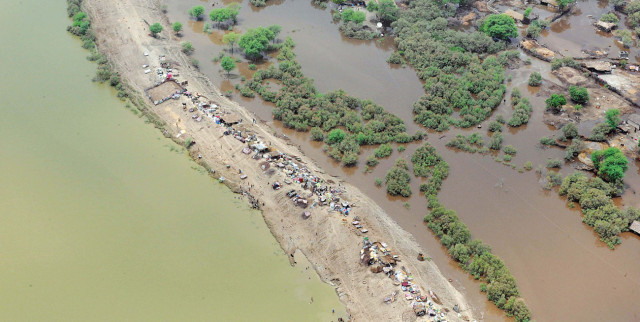Critical decisions ahead as barrages continue to resist
The army on Monday evening took control of Sukkur Barrage in a possible effort to save major parts of Sindh.

Critical decisions ahead as barrages continue to resist
While the Sukkur and Guddu barrages withstand the pressure of the surging floodwaters, officials have warned that a number of key dykes are cracking under the immense pressure of the flood waters. These dykes include that of Sukkur, which is reported to have already developed cracks. And as fears rise regarding the endurance levels of the Sukkur Barrage – a key structure for downstream and surrounding cities – decisions regarding deliberate breaching have come to the forefront.
Experts said that there is immense pressure on the Sukkur Barrage with 1,184,200 cusecs of water flowing downstream and 1,168,500 upstream on Tuesday evening. The pressure had amounted to 1,201,000 cusecs till the filing of this report.
If the barrage breaches, all major districts of Sindh, including Sukkur, Khairpur, Nawabshah , Sangar, Dadu and Hyderabad will witness flooding.
The only way to save the barrage is to make a breach in the Ali Wahan canal, said observers. On Sunday night, irrigation authorities were planning to break the embankment of Ali Wahan to reduce pressure on Sukkur Barrage, but were stopped by the area residents.
They said that this act would immediately flood the area that is the constituency of Labour and Manpower Minister Khursheed Shah. Sources say that there’s been a deadlock in the government circles about what to do next as there was no other but to make a cut in the canal “for the greater good of Sindh.”
Shah, however, was resisting all attempts. “The situation is even more complicated because since Shah is a member of our own ruling party and everyone is trying to convince him, but to no avail,” informed one source.
Shah was reportedly told in a high-level meeting in which the chief minister was also involved that this was not the first time that the breach would be made in Ali Wahan. The labour minister was reportedly informed that even in Zulfikar Ali Bhutto’s time, in 1976, when Sindh was under a similar threatening situation, a breach was made in Ali Wahan, which saved Sindh from widespread destruction, sources say. However, no argument was able to win the minister over.
Shah reportedly also paraded his people in front of TV cameras to ward off any attempts to make the breach in Ali Wahan.
Eventually, the Pakistan Army, which has now reportedly been given control of the Sukkur Barrage, intervened and reportedly also placed Shah under detention. The chief minister is reportedly trying to calm things down and secure his release. Till last reports, the army had fitted dynamites on walls of the Ali Wahan canal and was expected to detonate them soon.
The areas which are expected to be affected by the cut in Ali Wahan canal are old Rohri, Kandara, Saleh Pat, Khairpur’s Shadi Shaheed, Long Faqir, Sajjo Wah and Chundhko.
This latest drama comes under the backdrop of Irrigation Minister Jam Saifullah Dharejo’s act of making a cut in the Ghouspur. The chief minister reportedly was not informed of this decision, despite Saifullah’s saying that everyone was taken on board over the decision. The breach had caused flooding in Kashmore and there is now total devastation there. The move is being considered as a big blunder by the irrigation department.
The prime minister was asked to decide on two issues, one of which included making a cut in Ghouspur, while the other was concerned with blowing up the Khairpur-Larkana bridge. Gilani had reportedly asked the chief minister to decide on the Ghaus Pur cut, while instructions were given not to touch the Khairpur-Larkana Bridge unless the situation worsens.
It is also worth mentioning that Pir Pagara’s area in Khairpur’s Keengri has also been evacuated. However, people from surrounding areas have said that Pagara and his sons have constructed protection walls to protect their lands. However, irrigation officials believe that if the flood strikes then, these ‘bunds’ or walls will serve no purpose.
More than 75 per cent of Kachcha Bunder residents in Sukkur moved to safer places on Monday after floodwaters began escaping through the cracks of a dyke wall, inundating the surrounding area.
Several cracks appeared earlier on the protective wall of the dyke which was unable to sustain the pressure of the raging torrents.
Some families have also set up makeshift houses outside the bunder’s wall.
On early Monday morning, the gates of all seven off-taking canals were opened to release the water. Floods also caused cracks in the Kachcha Kharif Bund, which is being repaired by the locals.
The Begari Sindh Feeder developed 10 breaches at different points, flooding more than 50 villages. Residents of Karampur, Ghouspur, Dari, Tangwani, Badani and other places have started evacuating the areas while water from the Begari Sindh Feeder was heading towards Shikarpur and Garhi Tegho towns.
Floodwater inundated the Indus Highway between Rajanpur and Shikarpur and Guddu and Sadiqabad, while Guddu Barrage was closed for heavy traffic. The railway track between Shikarpur and Rajanpur was also submerged.
Residents of Guddu Colony have been told to move to safer places, while army has been deployed at the Guddu Thermal Power Station.
Emotionally charged people pelted the vehicle of labour and manpower minister with stones on Monday when he came to Bunder Wall to assess the damage that gushing waters had caused to the structure.
On Sunday, some cracks had developed in Bunder Wall near water works, which were taken care of, but on Monday night water started escaping from the wall near an under-construction residential plaza.
Hundreds of people from various localities had reached the spot and were busy piling up sandbags alongside the wall. People were furious because no government officials had shown up by that time.
As soon as Khursheed Shah reached the spot, people started pelting his vehicle with stones. The minister, however, remained unhurt and quickly eased into the vehicle and was driven away.
Irrigation officials later also reached the site and joined with the area people in repairing the cracks.
Meanwhile, according to a United Nations’ official on Monday, around 13.8 million people have been affected the current floods in the country making the scale of the disaster worse than the devastating 2004 tsunami.
“This disaster is worse than the tsunami, the 2005 Pakistan earthquake and the Haiti earthquake,” commented Maurizio Giuliano, a spokesperson for the UN Office for the Coordination of Humanitarian Affairs (UNOCHA).
“It is bigger because in the 2005 Pakistan earthquake, more than three million were affected, while in the tsunami some five million people were affected and the Haiti earthquake affected some three million,” he said. Giuliano called on relief operations “to be massively scaled up”.
About 220,000 people perished in the 2004 tsunami across Asia, while the United Nations has estimated the death toll from the Pakistan floods at 1,600. (With additional reporting from Sarfaraz Memon and agencies.)
Published in The Express Tribune, August 10th, 2010.



















COMMENTS
Comments are moderated and generally will be posted if they are on-topic and not abusive.
For more information, please see our Comments FAQ